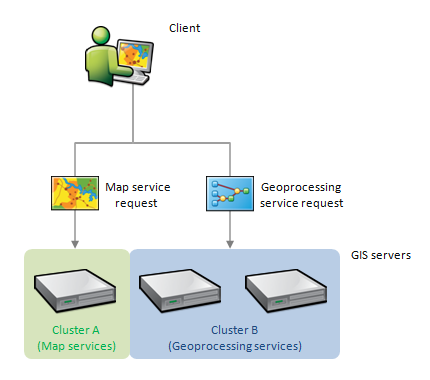ArcGIS Server machines configured to participate in an ArcGIS Server site can be organized into groups called clusters. Each cluster can be configured to run a dedicated subset of services. For example, you could create one cluster to run all your map services and another cluster of servers (perhaps with higher processing power) to run your geoprocessing services.
Legacy:
Sites with multiple clusters have been deprecated. The use of multi-cluster sites for new deployments is strongly discouraged and existing deployments are advised to migrate away from use of multi-cluster sites as part of ongoing maintenance and upgrades.

All ArcGIS Server machines in a cluster expose an identical set of services. The machines communicate with each other and attempt to assign each request to the machine that is most likely to be available. For example, in the diagram above, map service requests are routed to the ArcGIS Server machine participating in cluster A, while geoprocessing service requests are routed to the machines participating in cluster B. Additionally, you can add or remove machines from your cluster to respond to changing patterns in demand.
Load balancing and ArcGIS Server clusters
As of 10.4, ArcGIS Server defaults to single cluster mode for new installations. This mode does not include load balancing between machines in the cluster. This reduces network traffic between machines in the site, reduces load on your network, and helps improve monitoring of ArcGIS Server machines in your site. When upgrading to 10.4 or later from earlier releases, the mode will be enabled for sites with a single cluster that are not currently using single cluster mode. Single cluster sites already using single cluster mode and sites with multiple clusters at earlier releases will have their settings preserved when upgrading.
If your site uses more than one cluster, load-balancing is handled among all ArcGIS Server machines within each cluster.
For example, an incoming request is assigned to an available ArcGIS Server machine in the cluster, even if the request was directed to a specific machine within or outside of the cluster. That machine then does the work of drawing the map, finding the address coordinate, running the geoprocessing tool, and so on, and returns the result to the client. If a machine is offline or the service that was requested is running in a different cluster, the request is forwarded to the cluster containing the service. The ArcGIS Server machines in that cluster load-balance and process the request accordingly.
About the default cluster
An ArcGIS Server site must have at least one cluster. When you first create a site, a cluster called default is automatically generated for you. This cluster is configured to house the ArcGIS Server machine you used to create the site and run the preconfigured services installed with ArcGIS Server.
It is strongly recommended that you not delete the default cluster. If you delete the default cluster, any services assigned to it, including the pre-configured services that are critical to publishing and caching, will be stopped. If you require the services in the cluster to remain running, you'll need to edit the services to use another cluster before deleting the default. For instructions on how to change the cluster hosting a service, see Editing an ArcGIS Server cluster in Manager.
Cluster administration
You can use ArcGIS Server Manager or ArcGIS Desktop to create, edit, and delete ArcGIS Server clusters. For full instructions, see the links in the following sections.